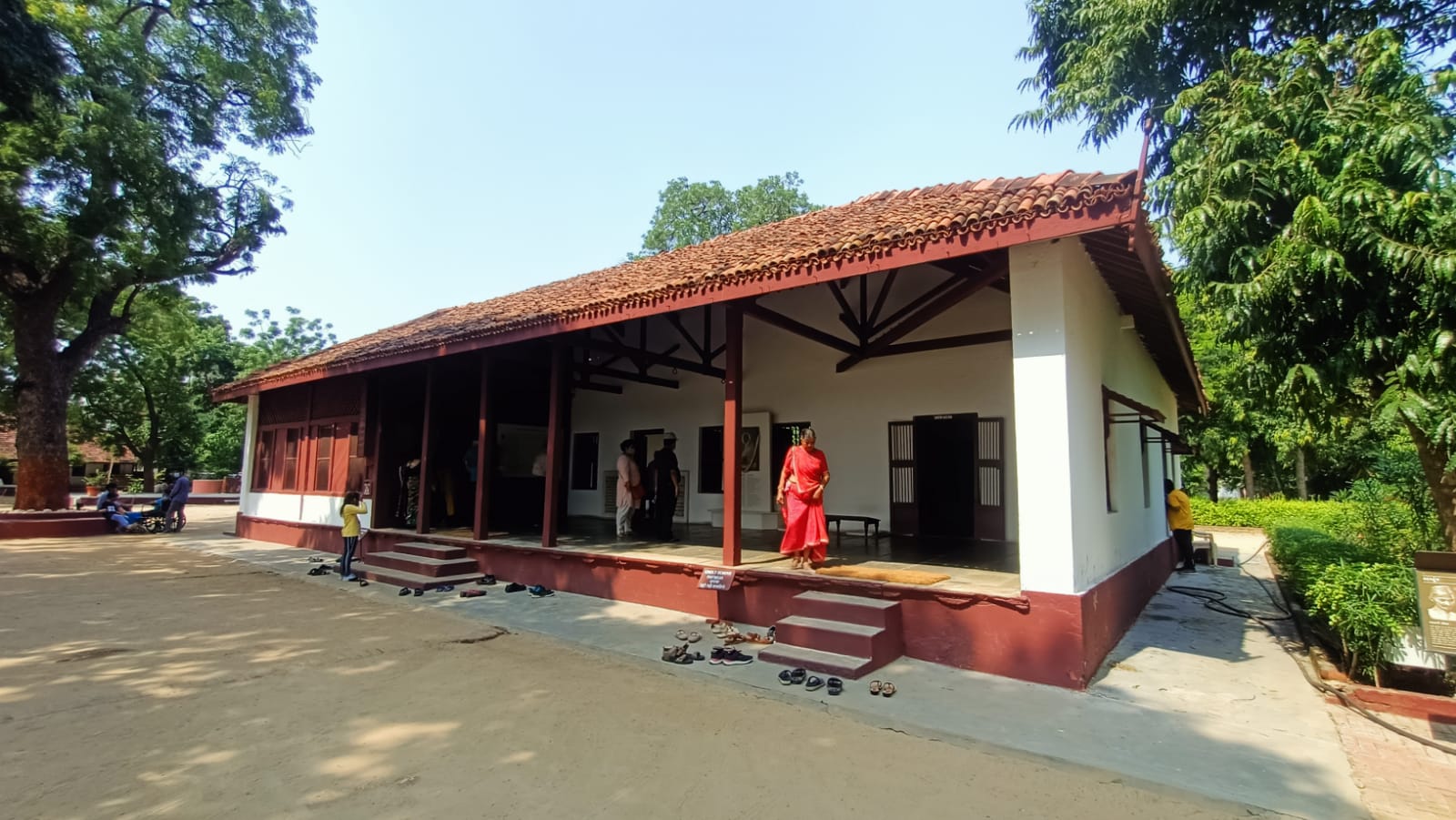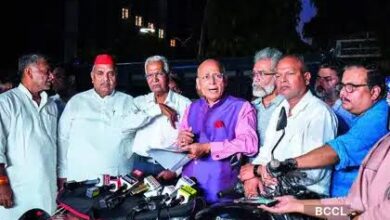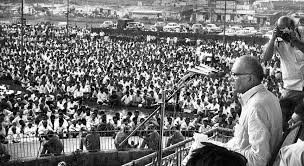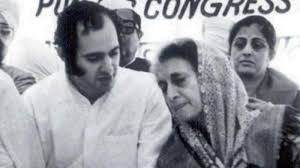My Lord! Where is the rest of 99 acres Land of Sabarmati Ashram
Journey of Gandhi’s Sabarmati Ashram: From Satyagraha to Harijan Service
Siby K. Joseph
The Gujarat High Court on November 25, 2021 rejected a Public Interest Litigation (PIL) filed by Mahatma Gandhi’s great-grandson Tushar Gandhi against Sabarmati Ashram redevelopment project in light of the submissions made by the Government.
“The government has given an assurance that the existing Ashram, which is in an area of one acre, would not be disturbed, and it will be maintained as it is. Thus, all the fears and apprehensions of the petitioner stand allayed in the government’s order,” Chief Justice Arvind Kumar said, while rejecting the PIL.
Despite the assurances by the government it is feared that redevelopment plans of Sabarmati Ashram-Ahmedabad would turn this modest place into a commercial attraction. As a result the people across the country and globe who believe in Gandhian principles are appealing to all to maintain the Ashram in its original form preserving its purity, simplicity and sanctity.
After the rejection of the plea by the High Court a lot of questions were asked by people in social media platforms about Satyagraha Ashram, its objectives, assets including the area of land possessed etc. Another question is what Gandhi wished when he finally abandoned the Ashram in 1933.
As we know, Gandhi started the Satyagraha Ashram in a rented building in May 1915 at Kocharab and it was shifted to a new location on the banks of river Sabarmati on June 17, 1917.
During that time Gandhi was engaged in Champaran Satyagraha in Bihar. A circular letter written by Gandhi for funds for the ashram from Motihari, Champaran on July 1, 1917 gives us an idea about the activities of the ashram those days.
He asked for funds for boarding and lodging of ashram inmates, hand weaving, the national school, propagation of Hindi language and for his political activities.
The letter also states that “A large plot of land is required for all these activities. Such a plot, admeasuring about 55 bighas, has already been purchased on the banks of the Sabarmati near the Sabarmati jail. Efforts are proceeding to buy some more.”
He also made it clear in the letter that for the land he spent the funds with him. Thus it is clear that the ashram had a number of activities and possessed around 20 acres of land even at the initial stages.
More land and buildings were added to it in the course of time due to surging of various activities. It was only in the year 1926, the Trust Deed of the Ashram was prepared and it was registered at the office of Sub-Registrar, Ahmedabad on February 12 .
It is interesting to note that in the declaration of the Ashram trust, Gandhi and his nephew Maganlal Gandhi described their profession as weavers and cultivators and residing at the Satyagraha Ashram. The accompanying schedule gives particulars of 18 pieces of land and buildings valuing Rs.2,75,000/-
The objectives of the Satyagraha Ashram, according to the trust deed, were:
1. Antyaja – uplift;
2. Cultivation of cotton, development of the crafts connected with it, hand-ginning, carding, spinning and weaving;
3. to train workers for activities necessary for the moral, economic and political uplift of India;
4. to establish and run schools to impart education in letters and other training; and
5. to undertake activities for cow-protection and improving the breed of cows, etc.
The first 5 trustees of the Ashram were: Jamnalal Bajaj, Revashankar Zaveri, Mahadev Desai, Imamsaheb Abdul Kadar Bawazeer and Chhaganlal Gandhi.
Though the original constitution was prepared in 1915 and revised constitution was published in Young India, on June 14, 1928. This constitution is worth reading to understand Gandhi’s vision of the Ashram.
It describes the eleven vows which were essential for the fulfilment of the object of the ashram and the various activities including worship, sanitary service, sacrificial spinning, agriculture, dairy, tannery, national education, khadi technical school and its syllabus of studies. Inter alia it also included the details of property owned by the Ashram.
It possessed land of “132 acres 38 gunthas in area,of the value of Rs.26, 972-5-6,and building worth Rs.2,95,121-15-6” which were held by the trustees. The total number of persons including men, women and children were 277.
This constitution at the end describes the daily routine of the ashram. The historic Dandi march which began on March 12, 1930 put an end to Gandhi’s stay in the ashram. Gandhi in his letter to Home Secretary, Government of Bombay, Ahmedabad, on July 26, 1933 had offered to the government to take over the Sabarmati Ashram. It owned those days immovable property estimated at about Rs. 3, 60,000 and movables including cash estimated nearly Rs. 2, 00,000. He wrote:“I suggest that the Government take possession of these and do what they like with them. … “
However the government did not take over the Ashram and Gandhi after due deliberation wrote to G. D. Birla, President, Servants of Untouchables Society, Delhi on September 30, 1933 to take-up ashram work for Harijan cause. “ …we came unanimously to the conclusion that it should be transferred to the all-India Harijan organization for all-India use.
The objects of the Trust are:
(i) to settle on the Ashram ground approved Harijan families subject to regulations to be framed;
(ii) to open a hostel for Harijan boys and girls with liberty to take non Harijans;
(iii) to conduct a technological department for teaching the art of skinning carcasses, tanning the hide so obtained, curing it and manufacturing leather so prepared into shoes, sandals and other articles of daily use; and lastly to use the premises as offices for the Central Board or the Gujarat provincial organization or both, and such other allied uses that the committee, referred to in the following paragraph, may think proper. On behalf of the trustees, I suggest that the Servants of Untouchables Society should appoint a special committee … to take over this Trust and to give effect to its objects.”
Please also read :
He added further “The buildings contain a spacious hostel easily accommodating 100 boarders. It has a fairly big weaving shed and other buildings exceptionally fitted for the uses I have named. The property contains 100 acres. … I hope that the Society will have no objection to accept the offer of the trustees and to take over the responsibility implied in the acceptance.” G. D.Birla in his reply on October 4, 1933, accepted Gandhi’s offer and requested him to ask those who were already there to continue to stay and look after the estate as before.
Thus it is clear that it was the wish of Mahatma that his ashram should rededicate itself for the cause of untouchables. It was difficult for All India Harijan Sevak Sangh to manage such diverse activities and autonomous trusts were formed to carry out the work after the assassination of Gandhi. If the ashram is looked upon as one acre of land with some buildings and museum, we are not doing justice to Gandhi’s wishes. Now all the stakeholders should make it a historic opportunity to rededicate for the constructive work for which it was established.
Gandhi”s Letter to Ghanshyamdas Birla
- LETTER TO G. D. BIRLA
SATYAGRAHA ASHRAM, WARDHA,
September 30, 1933
DEAR GHANSHY AMDAS,
As you are aware, the ‘Satyagraha Ashram’ grounds with the
buildings in Sabarmati were abandoned on the 1st of August
last by the Ashram people. I had expected that the Government
would, in view of my letter I addressed to them, take charge
of this abandoned property, but they did not do so. It then
became a question with me as to what was my duty in the circumstances.
I felt that it was wrong altogether to allow the
valuable buildings to waste. I consulted friends and co-workers
and came to the conclusion that the best use to make of the
Ashram was to dedicate it once for all for the service of the
Harijans. I placed my proposal before the trustees2 of the Ashram
who are out, as also fellow members. They have, I am happy to
say, whole-heartedly approved of it. When the property was
abandoned there certainly was the expectation that some day,
whether through an honourable settlement or India coming to her
own, the trustees would resume possession. Under the new proposal,
the trustees divest themselves entirely of the property.
This procedure is permissible under the Trust-deed3, service of
the Harijans being one of the objects of the trust. Therefore,
the new proposal is wholly in keeping with the letter
and spirit of the constitution4 of the Ashram, as also of the Trust.
The question that the trustees and I had to consider was, to
whom was the property to be transferred for the specific use I
have mentioned; and we came unanimously to the conclusion that
it should be transferred to the all-India Harijan organization for
all-India use. The objects of the Trust are: (i) to settle on the
Ashram ground approved Harijan families subject to regulations
to be framed; (ii) to open a hostel for Harijan boys and girls with
I Dated July 26, vide Vol. LV, pp. 301-4.
2 Jamna1a1 Bajaj and Chhaganla1 Gandhi
3 Vide Vol. XXIX, pp. 434-6.
4 Vide Vol. XXXVI, pp. 398-410.
41
42 THE COLLECTED WORKS OF MAHATMA GANDHI
liberty to take non-Harijans; (iii) to conduct a technological
department for teaching the art of skinning carcasses, tanning the
hide so obtained, curing it and manufacturing leather so prepared
into shoes, sandals and other articles of daily use; and lastly, to
use the premises as offices for the Central Board or the Gujarat
provincial organization or both, and such other allied uses that
the committee, referred to in the following paragraph, may think
proper.
On behalf of the trustees, I suggest that the Servants of
Untouchables Society should appoint a special committee with
yourself and the Secretary as ex-officio members, and three
Ahmedabad citizens, with power to this committee to add to
their number, to take over this Trust and to give effect to its
objects.
Two friends who have been always associated with the Ashram,
viz., Sjts. Budhabhai and Juthabhai, have offered to reside on
the premises as honorary managers. They have their own means
and have been devoted to the service of the Harijans for a long
time. There is also an inmate’ of the Ashram, who has dedicated
his life to Harijan service, and who will gladly stay on the
premises. He has almost become a specialist as a teacher of
Harijan boys and girls. The committee I have suggested, therefore,
should have no difficulty in managing the Trust; nor is it
necessary that all the activities I have mentioned should be simultaneously
and immediately undertaken. Some Harijan families,
as you are aware, are already living there. It has long been
a dream of the members of the Ashram to establish a colony of
Harijan families, but beyond having a few of them we were not
able to make further progress. Experiments in tanning were also
conducted there. Manufacture of sandals was going on up to the
time of disbandment. The buildings contain a spacious hostel
easily accommodating 100 boarders. It has a fairly big weaving
shed and other buildings exceptionally fitted for the uses I have
named. The property contains 100 acres. I venture to say,
therefore, that the site is none too large for the fulfilment of the
objects mentioned, but it is large enough for the response that
may be reasonably expected for some time to come. I hope that
the Society will have no objection to accept the offer of the
, Bhagwanji Purushottam Pandya who had left Burma to settle in the
Ashram
LETTER TO A TMA S. KAMALANI 43
trustees and to take over the responsibility implied III the acceptance.
1
SJT. GHANSHYAMDAS BIRLA
PRESIDENT
Yours sincerely,
M. K. GANDHI
SERVANTS OF UNTOUCHABLES SOCIETY
BIRLA MILLS, DELHI
C.W. 7937. Courtesy: G. D. Birla
[From: Collected Works of Mahatma Gandhi: Vol. 56, P
घनश्यामदस बिड़ला को गांधी जी का पत्र
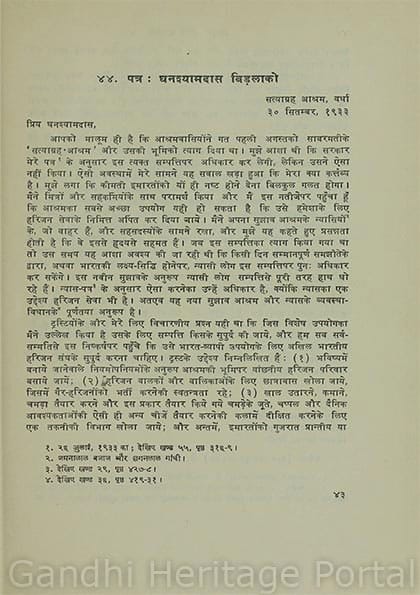
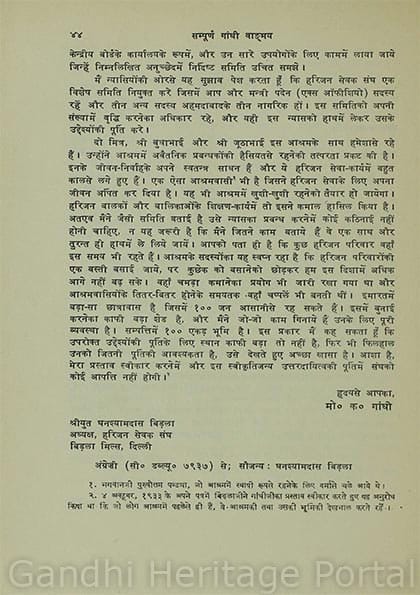
About the Author
Dr. Siby K. Joseph is Director, Sri Jamnalal Bajaj Memorial Library and Research Centre, Sevagram Ashram Pratishthan, Wardha-442102, Maharashtra. He is a noted academic and Gandhian Scholar having more than two decades of teaching and research experience. The books written and edited by him were published by Routledge, Concept, Manohar and many other publishing houses. His most recent writings are Lanza del Vasto: A Messenger of Peace (2018) Gandhi in South Africa: A Racist or A Liberator? (2019) Kasturba Gandhi: An Embodiment of Empowerment (2020).This Article is a part of series of articles on Ashrams established by Mahatma Gandhi
Email:directorjbmlrc@gmail.com

